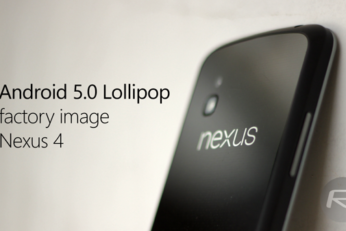Android's latest mobile software, dubbed Lollipop, is, if you'll excuse the terrible pun, the word on everybody's lips right now, but despite the numerous features having been refined and deemed ready for prime time, the typically cumbersome roll-out has since ensued. If you're an Android user, it's very likely that you'll be waiting a while before you can indulge in this new version 5.0, but if you happen to be in ownership of a Nexus, then you won't be left hanging for quite as long. Indeed, along with the earlier release of factory images for a spate of Nexus smartphones and tablets, the system image for the Nexus 4 is now in the wild, and if you're still in possession of this antiquated handset, then you can now… wait for it… get flashing!
As with any new update to Google's Android, many users are left in no man's land, waiting anxiously for that OTA to appear so they can go ahead and take advantage of the new features. Such is the fragmented nature of the operating system, devices are promised a new update from the get-go, but often have to wait weeks or even months before they can actually begin using it. The antiquated LG Nexus 4 will soon begin to see the recently released Android 4.4 KitKat, and although many in ownership of the handset have already successfully sought ways to force an update, you can now do so by flashing the update by your phone's recovery.
Now that Google and LG have finally put to bed the rumors and confirmed the new Nexus 5 handset, we can begin to concentrate on the actual important aspects of the device. Prior to its release, the Nexus 5 was undoubtedly one of the most leaked handsets that we have seen with images, purported technical specs and even video glimpses of the device appearing on an almost daily basis. The unofficial unveiling of the hardware didn't bring any surprises as the leaks had already told us pretty much everything that we need to know, except for one thing - how the device will perform in the real world and especially how it stacks up when compared against its predecessors in the Nexus range.
Despite being relatively old when compared to many devices currently on the market, the LG-made Google Nexus 4 continues to sell in strong numbers. Moreover, the recent price-drop, which saw significant amounts slashed from the cost of the Big G's already cheap-and-cheerful device, will have done its popularity no harm at all. But due to its age, the technology is not quite as fledgling as this time last year, and if you've checked the displays of devices like the Galaxy S4 or the HTC One, you'll know that the Nexus 4's screen looks a little washy by comparison. Thanks to the work of the guys over at XDA-Developers, notably member franciscofranco, you can inject a little much-needed life into your Nexus 4's display.
Step by step instructions on how to root Android 4.3 Jelly Bean running on Nexus 4, Nexus 7, Nexus 10 and Galaxy Nexus.
Apparently, a certain Jeff Williams got his hands today on a used Nexus 4 from a Googler – which was purportedly running Android 4.3. What was immediately discarded as a hoax turned out to be true just hours later, when certain individuals well-versed with Android helped Jeff get a system dump of the build that was there on his Nexus 4. From there, it was merely a matter of minutes to reach to a point where anyone with a Nexus 4 can play around with the “leaked” build and experience Android 4.3 before official release.
Google I/O was expected to play host to the grand unveiling of Android 4.3, but despite a number of key announcements pertaining to the search giant's flagship ecosystem, the next version of Android remained firmly off the agenda. Following the news (or lack thereof), many sources then went along with the story that Android 4.3 release date could be set somewhere around summer this year, and today, that notion has been offered a degree of legitimacy with the sighting of the bumped software running on an LG-manufactured Google Nexus 4.
Back when Google released the Nexus 4 in November of 2012, many lamented its lack of LTE. That wasn't enough to stop it from becoming something of a cult hit though. Thanks to an amazingly low price and the fact that it was one of the few Android phones to feature a stock Android experience, the device has gone on to prove hugely popular, despite its lack of 4G technology.
The LG-manufactured Google Nexus 4 has carried on many Nexus traditions, offering strong hardware specifications at an affordable price point. Not without its flaws, of course, it has made a reasonably good impression the consumer market nonetheless, and just recently, has been treated to a few minor modifications and design tweaks. Calling it a "refresh" would be a rather grandiose term to use, but the alterations, whilst not groundbreaking, are certainly noteworthy.
Linux enthusiasts rejoiced at the news that Canonical would be bringing Ubuntu to the mobile realm, and although it was promised a developer preview would be available for the Galaxy Nexus at some point early this year, it now looks as though the Nexus 4 will be joining it. From 21st of February, anybody in ownership of either device will be able to get a first look at the OS, which is set to release at some point in October, and although developers may not be leaping out their seats in excitement, it's hard not to take at least a fleeting interest in its progress.


